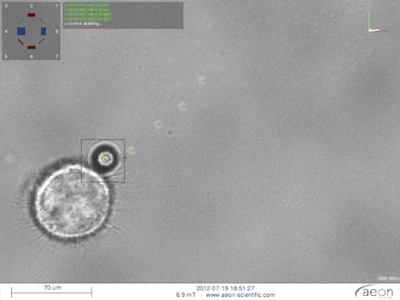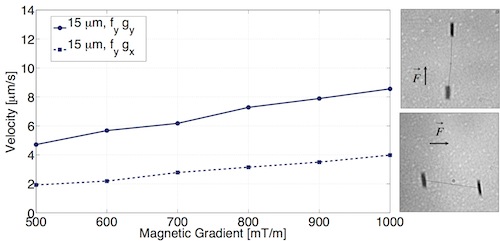3D Magnetic Biomanipulation
Applications
Controlled servoing of magnetic nanostructures is important in disciplines such as bioscience or biomedical engineering. In medicine, magnetic drug targeting is a promising technique for confined delivery of magnetic drug carriers to cancerous tissues or other infected areas in the body. Whereas common therapeutic methods such as chemotherapy target the entire body, magnetic guidance of functionalized nano/micro objects can reduce the exposure of healthy tissue and decrease the required drug volume. Biologists are interested in how cells can sense their microenvironment with specific receptors, translate them into intracellular commands, and respond accordingly. Many biological processes depend on this active dialogue between cells and their environments. Mechanical forces applied either by neighboring cells through cell-cell contact or by other external factors contribute to several cellular functions, including changes in gene expression, and differentiation. Studying these processes at the cellular level requires a minimally-invasive technology that can deliver precise signals with high spatiotemporal resolution. The ability to manipulate and remotely control cell behavior has the potential to be a powerful tool for investigating cellular function and intracellular signaling networks.
System
The MiniMag is a magnetic manipulation system capable of 5 degree-of-freedom (5-DOF) wireless control of micro- and nano structures (3-DOF position, 2-DOF pointing orientation). It is integrated in an inverted microscope and can generate arbitrary magnetic fields and gradients and combinations thereof at a field strength of up to 50 mT and gradients up to 4 T/m at 2 kHz. Multiple types of magnetic control techniques can be applied which include field and gradient propulsion, stick-slip motion, rotating magnetic fields, oscillating magnetic fields, and their combinations.
Studies

The control of magnetic nanoobjects is challenging in two aspects: first, the governing equations for objects in fluids at this scale are derived from the low Reynolds number regime where fluid viscosity and surface effects dominate volumetric effects such as inertia. Second, the force generated by a magnetic gradient that pulls on a magnetized object scales with the inverse of the third power of the dimension. Hence, high magnetic gradients are required, which are difficult to generate from an engineering perspective. The capability of the MiniMag, however, enables the generation of sufficient magnetic forces to manipulate structures at the nanoscale in a holonomic fashion.
Fluid Dynamics
The system allows for the experimental exploration of fluid dynamics at low Reynolds regimes and fundamental studies of the principles of motion of nanostructures. The drag anisotropy of a cylindrical object can be investigated and measured as a nanowire is pulled along, perpendicular or at an arbitrary orientation with respect to its long axis respectively.
Manipulation at the Cellular Level
The studies of phagocytosis, the process when cells engulf solid particles, are of interest in several biological applications. When it comes to phagocytosis of macrophages, i.e reactions of the immune system, knowledge of the process can be useful for drug design. When these solid particles are made of a magnetic material with a specific surface functionalization, they can be delivered to the cell as a trojan and the interactions can be studied.

